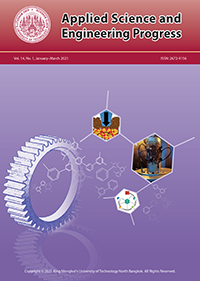Feasibility of Using Natural Rubber (NR) Latex Foam as a Soft Robotic Finger: Role of Foaming Agent in Morphology and Dynamic Properties of NR Latex Foam
Main Article Content
Abstract
Sarcopenia caused by ageing and muscle loss is mostly found in the elderly people. Since a number of older people have been increased, a device which assists with grasping can play an important role in an ageing society. The purpose of this research is to select the material which is potentially a part of soft robotic actuator. Natural rubber (NR) latex produced locally in Thailand is intentionally chosen and chemically vulcanized by using a conventional vulcanization system into a molded fingered foam. The research focuses on varying the amount of foaming agent (Benzene sulfonyl hydrazide, BSH). Effect of foaming agent quantity on morphology and dynamic properties of the prepared natural rubber foam was elucidated. The suitable foam formula is selected and molded as the human fingers in the structure of a potential soft robotic actuator which were tested for the movement.
Article Details
References
[2] S. Majumder, E. Aghayi, M. Noferesti, H. Memarzadeh-Tehran, T. Mondal, and P. M. J. Deen, “Smart homes for elderly healthcare-recent advances and research challenges,” Sensors, vol. 17, no. 11, p. 2496, 2017.
[3] B. S. Homberg, R. K. Katzschmann, M. R. Dogar, and D. Rus, “Robust proprioceptive grasping with a soft robot hand,” Autonomous Robots, vol. 43, pp. 681–696, 2018.
[4] K. Batsuren and D. Yun, “Soft robotic gripper with chambered fingers for performing in-hand manipulation,” Applied Sciences, vol. 9, p. 2967, 2019.
[5] D. Rus and M. T. Tolley, “Design, fabrication and control of soft robots,” Nature, vol. 521, pp. 467–475, 2015.
[6] F. Schmitt, O. Piccin, L. Barbé, and B. Bayle, “Soft robots manufacturing: A review,” Frontiers in Robotics and AI, vol. 5, pp. 1–16, 2018.
[7] J. Y. Nagase, S. Wakimoto, T. Satoh, N. Saga, and N. Suzumori, “Design of variable-stiffness robotic hand using pneumatic soft rubber actuators,” Smart Materials and Structures, vol. 20, p.105015, 2011.
[8] Y. Yang, Y. Chen, Y. Wei, and Y. Li, “Novel design and three-dimensional printing of variable stiffness robotic grippers,” Journal of Mechanisms and Robotics, vol. 8, p. 061010, 2016.
[9] L. J. Leslie, M. J. Jenkins, D. E. T. Shepherd, and S. N. Kukureka, “The effect of the environment on the mechanical properties of medical grade silicones,” Journal of Biomedical Materials Research Part B Applied Biomaterials, vol. 86, pp. 460–465, 2008.
[10] K. M. Raghu, C. R. Gururaju, K. J. Sundaresh, and R. Mallikarjuna, “Aesthetic finger prosthesis with silicone biomaterial,” BMJ Journal, vol. 2013, Aug. 2013, doi: https://doi.org/10.1136/bcr-2013- 010385.
[11] MICE Intelligence Center “Tire and Rubber Industry of Thailand,” Oct. 24, 2019. [Online]. Available : https://intelligence.businesseventsthailand.com/ en/industry/tire-and-rubber
[12] R. J. Schaefer, “Mechanical properties of rubber,” in Harris Shock and Vibration Handbook. New York: McGraw Hill, 2009, pp. 33.1–33.18.
[13] S. Sirikulchaikij, R. Kokoo, and M. Khangkhamano, “Natural rubber latex foam production using air microbubbles: Microstructure and physical properties,” Materials Letters, vol. 260, p. 126916, 2020.
[14] F. L. Jin, M. Zhao, M. Park, and S. J. Park, “Recent trends of foaming in polymer processing,” Polymers (Basel), vol. 11, p. 953, 2019.
[15] S. M. Rangappa, S. Siengchin, and H. N. Dhakal “Green-composites: Ecofriendly and sustainability,” Applied Science and Engineering Progress,” vol. 13, no. 3, pp. 183–184, 2020, doi: 10.14416/j. asep.2020.06.001.
[16] S. Srisawadi, S. Lapapong, S. Dokkhan, and P. Wiroonpochit, “Stereolithography of natural rubber latex, a highly elastic material,” presented at the 30th Annual International Solid Freeform Fabrication Symposium-Additive Manufacturing Conference 2019, Texas, United States of America, Aug. 12–14, 2019.
[17] M. A. Quetzeri-Santiago, C. L. Hedegaard, and J. R. Castrejo´ n-Pita, “Additive manufacturing with liquid latex and recycled End-of-Life rubber,” 3D Printing and Additive Manufacturing, vol. 6, pp. 149–158, 2019.
[18] M. Lukic´, J. Clarke, C. Tuck, W. Whittow, and G. Wells, “Printability of elastomer latex for additive manufacturing or 3D printing,” Journal of Applied Polymer Science, vol. 133, p. 42931, 2016.
[19] ASTM Standard Specification for Rubber- Concentrated, Ammonia Preserved, Creamed, and Centrifuged Natural Latex, ASTM D1076-15, 2015.
[20] B. A. Hunter and L. Schoene, “Sulfonyl hydrazide blowing agents for rubber and plastics,” Industrial & Engineering Chemistry, vol. 44, pp. 119–122, 1952.
[21] G. Wypych, “Databook of blowing and auxiliary agents,” in Elsevier, Technology and Engineering. Ontario, Canada: ChemTec Publishing, 2017, pp. 193–195.
[22] A. Y. Coran, “Vulcanization,” in Science and Technology of Rubber (Second Edition), San Diego: Academic Press, pp. 339–385, 1994.
[23] A. Y. Coran, “Vulcanization,” in Science and Technology of Rubber (Fourth Edition), San Diego: Academic Press, pp. 337–381, 2013.
[24] R. H. Campbell and R. W. Wise, “Vulcanization. Part I. fate of curing system during the sulfur vulcanization of natural rubber accelerated by Benzothiazole derivatives,” Rubber Chemistry and Technology, vol. 37, pp. 635–649, 1964.
[25] N. J. Morrison and M. Portor, “Temperature effects on the stability of intermediates and crosslinks in sulphur Vulcanization,” Rubber Chemistry and Technology, vol. 57, pp. 63–85, 1984.
[26] P. Ghosh, S. Katare, P. Patkar, J. M. Caruthers, and V. Venkatesubramanian, “Sulphur vulcanization of NR for Benzothiazole accelerated formulations: From reaction mechanism to rational kinetic model,” Rubber Chemistry and Technology, vol. 76, pp. 592–693, 2003.
[27] ASTM Standard Test Method for Rubber- Determination of Gel, Swelling Index, and Dilute Solution Viscosity, ASTM D3616 – 95, 2019.


